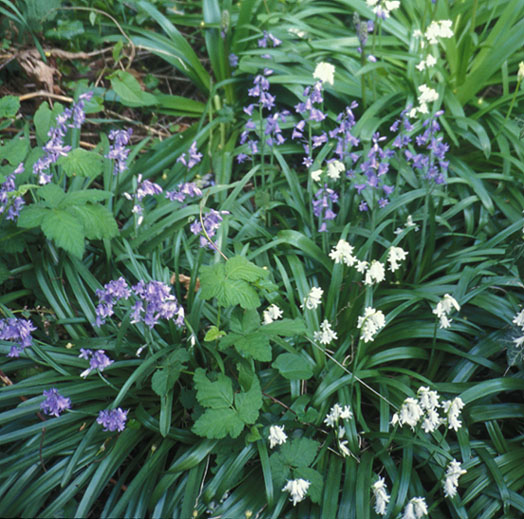
|
| Bluebell; Hyacinthoides hispanica (Mill.) Rothm. |
| = Endymion hispanicus (Mill.) Chouard |
Lily Family; LILIACEÆ
|
| This is no standard weed. Spanish Bluebell is chiefly a garden ornamental and secondly a weed. As the name implies, this
species' native land is west Spain, Portugal, and extreme northwest Africa. But the beauty and vigor of the flower have caused it to be grown
in much of the world. No stronger, more persistent flower-bulb grows in Seattle gardens, and it certainly can qualify as a weed. |
| The bulbs are white, slimy, usually not buried very deep, and range from marble to golfball size: that is, no more than about
11/2 inches thick. In late December or in January they push above ground dark green, slender, tender, succulent leaves, that when rubbed or
stepped upon squeak and crunch. The flowerstems shoot up after the clump of shiny leaves, and bloom from late March until late May,
standing usually 10 to 30 inches, at most up to 40 inches tall. The little flower "bells" are in a few cases pink or white. But these lack the
amazing power of their blue kin. Some flowers give rise to plump seedpods. Thus the Bluebells can spread by reseeding, by bulb-multiplying,
and when gardeners dump excess bulbs somewhere. |
| They tolerate much shade, are indifferent regarding soil quality, and seem free of pests and diseases. After the flowers fade, the
plants gradually wither away, with the flowerstems turning to straw by late summer. Whether in any way poisonous, or otherwise important,
is unknown. Books afford almost no helpful information about them. A close cousin called English Bluebell
(H. non-scriptus), has had its bulbs made into good, useful pastes, gums and glues. |
| The name Bluebell is given to various flowers in many regions. In Seattle it generally refers to this weedy, very common bulb.
Other names are Wild Hyacinth or Wood Hyacinth; and some of us still call it Squill: a hangover from its outdated scientific names
Scilla hispanica or Scilla campanulata. It really does look like a relaxed, slender version of the puffed-up garden Hyacinth bulbs. Most of the Bluebells
that are weediest, are neither English nor Spanish: but hybrids. Such hybrids demonstrate supreme toughness, grow larger, and often set seeds. (Their botanical name is Hyacinthoides x Massartiana Geerinck 1996) |
| To combat an infestation, dig up the bulbs and drown, mash, microwave or
dry them thoroughly before composting them. It may take searing summer heat or attic dryness to render the bulbs a fatal blow. Maybe it is more practical to try drowning them: put them into a
tub of water for a few months. The leaves and flowers can be composted with no fear of their resurrection. |
In the Language of Flowers, Spanish Bluebell signals "Pleasure without alloy." And it really is pretty enough to give such
pleasure. But a weed it can be too, spreading without end. So we cherish it or curse it, depending upon how many we have.
|
Originally published as the Seattle Tilth newsletter Weed of the Month in June 1986, along with an illustration drawn by Jerri Geer.
Back |
|
|

